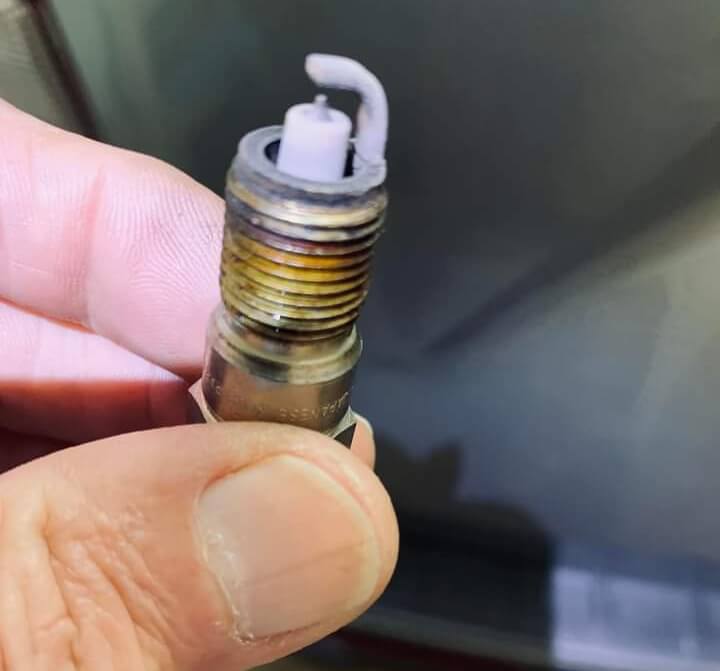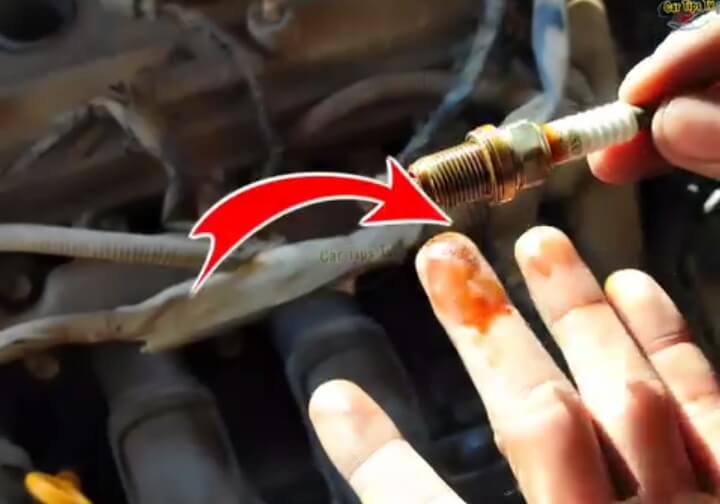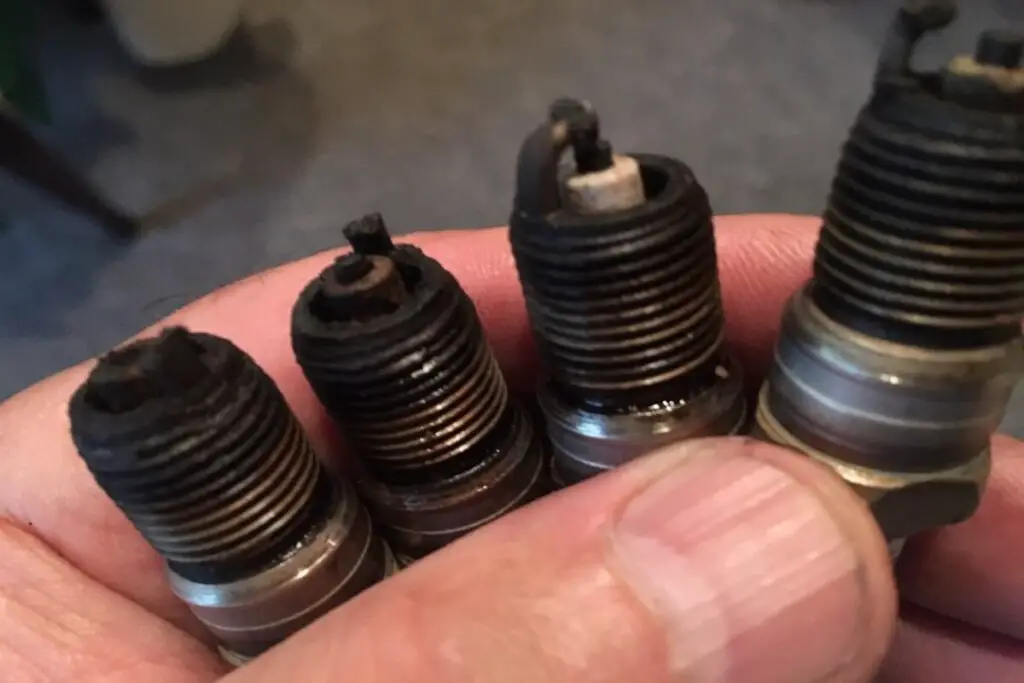As an Amazon Associate, we earn from qualifying purchases. This does not affect the price you pay or the quality of the products you buy. For more information, please read the full affiliate disclosure here.
A white tip on the spark plug indicates that your engine is running too hot and lean. This means that the fuel-air mixture in the combustion chamber is not balanced, and there is more oxygen than fuel. The excess oxygen burns the spark plug tip and leaves a white residue on it. The residue can also be caused by fuel impurities and iron oxide that react with the spark plug.
A white spark plug is a sign of a serious problem that needs to be fixed as soon as possible. It can cause engine damage, poor fuel economy, and reduced performance.
In this blog post, we will explain why the spark plug turns white, what the possible causes are, and how to solve this issue. Let’s get started!
Causes of White Spark Plug Tips

When you inspect your spark plugs and notice white deposits on them, it’s a sign that something is not right with your engine. Here are some main causes of white spark plugs:
1. Lean Fuel Mixture
The most common reason for white deposits on spark plugs is a lean fuel mixture. This means that there is too much air and not enough fuel in the combustion chamber. A lean fuel mixture can be caused by several factors, including:
- Low fuel pressure
- A bad engine sensor
- A bad fuel pump
- Low-quality fuel
2. Engine overheating
Another reason for white deposits on spark plugs is engine overheating. When the engine overheats, the spark plugs can get too hot and burn off the fuel deposits, leaving behind white ash. Engine overheating can be caused by several factors, including:
- A malfunctioning cooling system
- A clogged radiator
- A faulty thermostat
3. Wrong spark plug
If the spark plug is not compatible with your engine, it can cause the engine to run too hot and lean. For example, if the spark plug is too long, it can protrude into the combustion chamber and interfere with flame propagation. If the spark plug is too short, it can cause poor spark and incomplete combustion. If the spark plug has the wrong heat range, it can either overheat or fail to reach the optimal temperature for ignition.
Effects of White on the Spark Plug
The effects of a white spark plug can include engine misfires, reduced fuel efficiency, and engine damage.
1. Engine misfires
A misfire occurs when the spark plug fails to ignite the fuel-air mixture in the combustion chamber. This can be caused by a variety of factors, including a faulty spark plug, a clogged fuel injector, or a malfunctioning ignition system. The presence of white deposits on the spark plug can exacerbate this issue by interfering with the spark plug’s ability to generate a spark.
2. Reduced fuel efficiency
When your engine is not running efficiently, it can lead to decreased fuel economy. White deposits on the spark plug can cause your engine to run hotter than normal, which can lead to poor fuel efficiency. This is because the deposits can interfere with the combustion process, causing the engine to work harder to produce the same amount of power.
3. Engine damage
If left untreated, white deposits on the spark plug can cause serious engine damage. Overheating can cause the spark plug to melt, which can lead to catastrophic engine failure. In addition, the presence of white deposits can be a sign of other underlying issues, such as a lean air-fuel mixture or a malfunctioning cooling system, which can cause further damage to your engine over time.
How to Fix White Spark Plug Tips
The first step to fixing white spark plug tips is to diagnose the root cause of the problem. You can use a scan tool to check for any trouble codes stored in the engine computer. You can also inspect the spark plugs visually and measure the spark plug gap. You can also perform a compression test and a fuel pressure test to check the condition of the engine and the fuel system. Once you identify the cause of the problem, you can take the following steps to fix it:
1. Replace the spark plugs.
If the spark plugs are white, burned, or damaged, you need to replace them with new ones that match your engine specifications. You can consult your owner’s manual or a mechanic for the correct spark plug type, size, and gap. You should also replace the spark plug wires if they are worn or corroded.
2. Clean or replace the fuel filter.
If the fuel filter is dirty or clogged, it can restrict the fuel flow and cause a lean condition. You can either clean the fuel filter with a solvent or replace it with a new one. You should also check the fuel lines and hoses for any leaks or cracks.
3. Replace the fuel pump or fuel injectors.
If the fuel pump or fuel injectors are faulty or failing, they can reduce the fuel pressure and volume, resulting in a lean mixture. You can either repair or replace the fuel pump or fuel injectors, depending on the severity of the problem. You should also check the fuel pressure regulator and the fuel rail for any malfunctions or blockages.
4. Replace the engine sensor.
If the engine sensor is defective or inaccurate, it can send the wrong signals to the engine computer and cause the engine to run lean. You can either repair or replace the engine sensor, depending on the type and location of the sensor. You should also check the wiring and connectors for any damage or corrosion.
5. Adjust the air-fuel ratio.
If the air-fuel ratio is too low, you can adjust it by using a scan tool or a tuning device. You can either enrich the mixture by increasing the fuel injection or decreasing the air intake, or you can lean on the mixture by decreasing the fuel injection or increasing the air intake. You should also check the air filter and the intake manifold for any dirt or leaks.
Preventing White on the Spark Plug

Since white spark plugs can be a sign of various problems within your engine, there are steps you can take to prevent them from occurring in the first place. Here are some preventive measures you can take to avoid white-on spark plugs:
Regular Maintenance
One of the most important steps you can take to prevent white on the spark plug is to perform regular maintenance on your engine. This includes changing your oil and air filters regularly and ensuring that your engine is running at the correct temperature. By keeping your engine in good condition, you can help prevent problems like overheating and lean fuel mixtures that can cause a white spark plug.
Proper fuel mixture
A common cause of white spark plugs is a lean fuel mixture. This occurs when there is not enough fuel present for proper combustion. To prevent this, it is important to ensure that your engine is receiving the correct fuel mixture. This can be achieved by checking your fuel pressure, replacing worn fuel pumps, and cleaning or replacing clogged fuel filters. Additionally, using high-quality fuel can help prevent white on the spark plug.
Correct Spark Plug Selection
Choosing the correct spark plug for your engine is another important step in preventing white spark plugs. Using the wrong spark plug can cause problems like overheating and incorrect combustion, which can lead to a white spark plug. To prevent this, it is important to choose the correct spark plug for your engine and to replace your spark plugs regularly. You can consult your owner’s manual or a mechanic to determine the correct spark plug for your engine.
Frequently Asked Questions
What causes a spark plug to appear white?
White spark plug tips are usually caused by a lean air-fuel mixture, which means there is too much air and not enough fuel in the combustion chamber. This can be due to a variety of reasons, such as a dirty air filter, a faulty fuel injector, or a vacuum leak. When the air-fuel mixture is too lean, the spark plug will run hotter than normal, causing the electrode to appear white.
How can I tell if my spark plug is filled with oil or gasoline?
If your spark plug is filled with oil, it will have a black, oily appearance on the electrode. This is usually caused by a problem with the engine’s oil system, such as worn piston rings or valve guides. If your spark plug is filled with gasoline, it will have a wet appearance and smell like gasoline. This is usually caused by a problem with the engine’s fuel system, such as a faulty fuel injector or carburetor.
What are the symptoms of a wet spark plug?
A wet spark plug can cause a variety of symptoms, such as a rough idle, hesitation, or misfire. This is because the excess fuel on the spark plug can cause the spark to be weakened, making it harder for the engine to start. In addition, the excess fuel can cause the spark plug to foul, which can lead to further problems.
What is the significance of the spark plug color?
The color of a spark plug can give you important information about how your engine is running. A normal spark plug should have a light brown color on the electrode. If the electrode is white, it can indicate a lean air-fuel mixture. If the electrode is black, it can indicate a rich air-fuel mixture. If the electrode is oily, it can indicate a problem with the engine’s oil system.
How do I read a spark plug for tuning?
Reading a spark plug can help you tune your engine for optimal performance. To read a spark plug, remove it from the engine and examine the color of the electrode. A light brown color indicates a normal air-fuel mixture, while a white color indicates a lean air-fuel mixture, and a black color indicates a rich air-fuel mixture. Adjusting the air-fuel mixture can help improve your engine’s performance.
Can I clean a spark plug that appears white?
It is possible to clean a spark plug that appears white, but it is not recommended. The white color is usually caused by a lean air-fuel mixture, which can cause the spark plug to run hotter than normal. Cleaning the spark plug may temporarily fix the problem, but it will not address the underlying issue. It is best to diagnose and fix the root cause of the problem to prevent further damage to the engine.
The Final Words
The color of your spark plug can tell you a lot about the health of your engine. If you notice white residue on your spark plug, it is important to address the underlying issue as soon as possible.
White spark plug tips are a sign of a serious engine problem that can affect its performance and safety. The main cause of white spark plug tips is a lean air-fuel mixture, which can be caused by low fuel pressure, a bad engine sensor, the wrong spark plug, or other factors.
To fix white spark plug tips, you need to diagnose the problem and replace the spark plugs and other faulty components. You also need to adjust the air-fuel ratio to achieve the optimal balance for your engine. By following these steps, you can restore your engine’s health and prevent white spark plug tips from happening again.
If you are unsure about any aspect of spark plug maintenance or repair, it is always best to consult a professional mechanic. They can provide expert advice and help you keep your engine running smoothly.
Share


